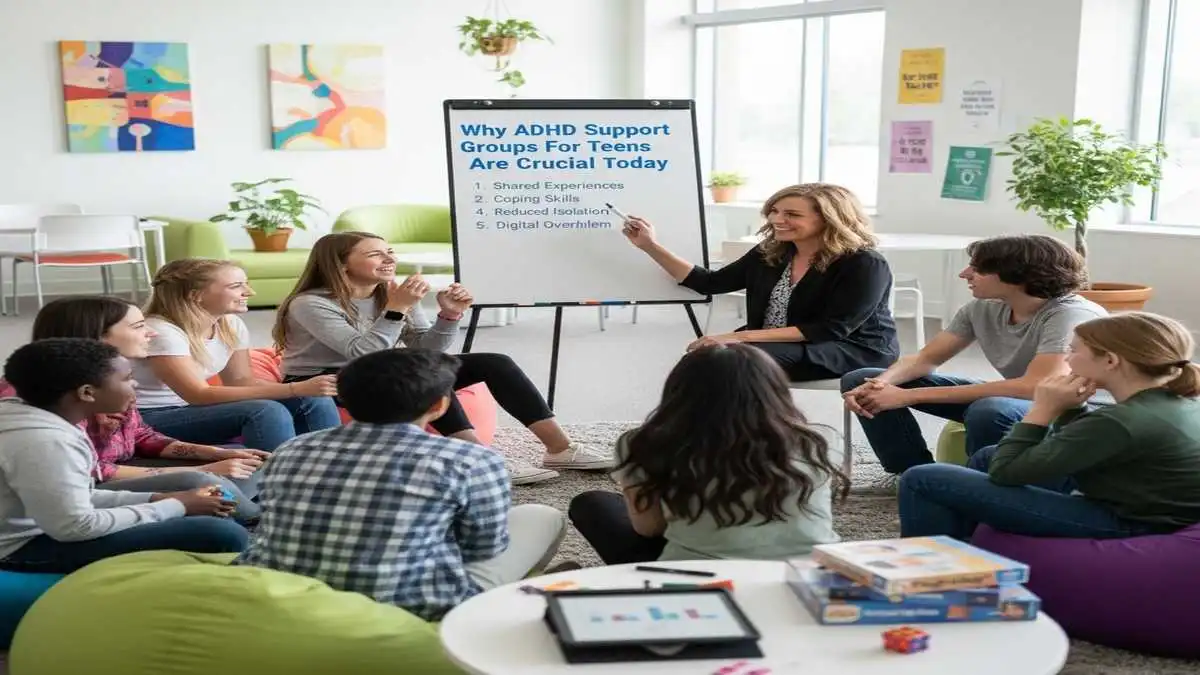HEALTH AND FITNESS
Why ADHD Support Groups for Teens Are More Important Than Ever

Young people with ADHD are often lonely in this busy world. Attention and impulsivity problems are only part of the issue. ADHD executive function challenges come with low self-esteem, social problems, and emotional challenges. For these individuals, finding a supportive friend group can make a world of difference. This is why ADHD support groups for adolescents need to be a bigger focus within mental health advocacy.
During the initial stages of having ADHD, teenagers often feel like no one understands them or is going through the same experience. Without seeing people like them in the classroom or the media, younger individuals can feel like there is a huge gap, and self-esteem problems can deepen. Getting connected with a positive and supportive group can be a huge game-changer that can ignite hope for better coping strategies and provide flexibility for the issues facing life.
Support groups can give more than just the socialization piece. It is important to connect them with professional support that can help in a more targeted way. This is why the ADHD support groups for adolescents are most effective when included in a comprehensive plan.
Table of Contents
The Growing Need for Connection in Adolescents with ADHD
Adolescence is already a period of identity formation, peer pressure, and emotional turbulence, and for those with ADHD, the challenges only intensify. Restlessness, impulsive actions, missed assignments, and misunderstandings with teachers and peers contribute to a negative feedback loop of isolation. Instead of seeking help, the trapped individual may self-blame and retreat into a silence that is almost screaming for support.
Social support and peer understanding can help counterbalance crippling self-criticism, anxiety, and depression. When ADHD-affected teenagers join a group where openly talking about their experiences is the norm, strategy exchanges and empathic listening help begin their relational and emotional healing and formation. They adapt, learn to cope, and realize that succeeding is possible.
Adolescents often cite the most important part of therapy as the realization that they are not alone. Support groups help therapists magnify this effect by offering continuity, fostering peer mentorship, and using feedback in a guided environment. All of this makes ADHD support groups for adolescents a uniquely powerful mental health aid.
What Makes a Good Support Group for ADHD Teens
Considering the differences in training and expertise across the participants for support group facilitation, ADHD groups for teens can differ in quality and effectiveness. Quality groups for teens with ADHD will have the following basic components.
- A group leader (psychiatrist, therapist, or counselor) trained in ADHD and worked with teens.
- An opportunity to talk and listen to other group members in a safe, non-judgmental, and respectful environment
- An opportunity to talk and listen to other group members in a safe, non-judgmental, and respectful environment
- Opportunities for peer mentoring, allowing group members to take on the mentoring role and guide younger participants, or in other adolescent mentoring
- Incorporation or alignment with ADHD professional treatment (care, medications, educational adjustments)
- Regular ongoing meetings rather than a one‑off session (weekly or biweekly)
With such components in place, these groups can go a long way in helping teens ADD with their social communication.
Social, Emotional, and Academic Gains for Adolescents
Strengthening Social Connection
Teens in these groups often experience a sense of belonging. They realize they are not the only ones who struggle with distractions, forgetfulness, or impulsive remarks. With time, they form friendships based on empathy, something that is often missing from other social groups. These friendships, and the relational anchors they provide, can help with shame and loneliness during these rough years.
Improving Emotional Regulation
Adolescents in the group learn to express their emotions and articulate their frustrations, disappointments, and hopes. Witnessing their peers identify emotions helps them to grow in emotional self‑compassion and acquire a positive emotional vocabulary. They understand that frustration is not synonymous with failure, and that setbacks can be an opportunity to devise new strategies.
Exchanging Practical Tools
As professionals deliver evidence‑based interventions, adolescents enrich peer support with their personal experience. Teens acquire new, “creative” techniques, ike planners that actually work, prioritizing, reminding, and breaking tasks into smaller steps, from someone who has tested them. “Peer-tested” strategies c “n feel more relatable than strategies described in textbooks.
Growing Confidence and Self-Advocacy
When group members celebrate achievements, no matter how small, everyone’s confidence increases. Young people recognize that they are active participants in their care and are able to ask for accommodations at school, negotiate deadlines, and talk to teachers and parents. Eventually, they reaffirm the message, “I’m not broke. I can learn to manage this with help.”
Coordination with Professional Treatment
When therapy is infrequent, it is hard to maintain momentum. But in a series, peers can check in on each other’s goals. Others can encourage follow-through and celebrate small wins. Progress is hard to maintain when fatigue, setbacks, or school stress come. But empathetic accountability helps when it’s needed most in coordination with Professional Treatment.
ADHD support groups for adolescents should complement, and not replace, professional care. Evidence-based treatment for ADHD support includes clinical assessment, individual therapy, medication when appropriate, and school accommodations and support. The support group helps to strengthen that layer by providing ongoing peer connection and real-world feedback.
When professional resources align with peers in the group. Teens feel validated when their peers reinforce the techniques introduced in therapy. Hearing about others’ journeys, roadblocks, and solution perspectives enriches their own treatment narratives.
Overcoming Common Group Challenges
Each challenge that comes with running a group for adolescents with ADHD is manageable with intentionality.
Attendance Gaps
Increased school pressures, extracurricular activities, and motivational dips can lead to attendance gaps. To counter this, facilitators can include hybrid options and send reminders. Improvising Attendance can help develop a culture of acceptance with attendance lapses, skips, and breaks.
Dominating Voices and Silent Participants
It’s a tough situation for some teens to dominate a conversation while others sit passively. Facilitators can use structured guided group moving to ensure that every person participates.
Confidentiality
Adolescents want privacy. Gaps in trust or expectations of confidentiality will shut down the group. Facilitators should reinforce the no spying, the dictatorship isn’t rising, and the safe space at every meeting.
Coping with Emotional Intensity
Certain subjects can provoke emotions such as shame, frustration, or sadness. Having facilitators be able to assist with coping strategies during the session is important. This can include redirection, allowing participants to take a break, or offering a private check-in after the session.
Starting/ Finding ADHD Support Groups for Teens
In case your community is missing these resources, or the quality is not what you’re expecting, follow these steps to get started.
- Involve mental health professionals. Look for a psychologist, counselor, or social worker who is knowledgeable about ADHD in adolescents and can help co-lead or endorse the sessions.
- Decide on a regular meeting time and format. Having a meeting day and time (e.g., weekly or biweekly) at the same time works best for everyone. Decide if sessions will be virtual, in person, or a combination.
- Create a curriculum or topic roadmap. Think about the frameworks for your sessions, such as study planning, executive function, social skills, emotional regulation, self-care, and similar ones.
- Publicize with schools, clinics, and community centers. Advertise this opportunity to guidance counselors, pediatricians, mental health clinics, and parent groups.
- Set group rules and confidentiality agreements. Having a welcome packet or orientation will help communicate confidentiality and sharing boundaries, expected participation, and emergency procedures.
- Bring in pilot members. Start with a few teens who need help, then refine scheduling, pacing, and subjects by their feedback.
- Assess and adjust. Ask for feedback on a regular basis, and it can be anonymously, to help determine changes with content, pacing, and structure. Get feedback on what’s effective and what isn’t, particularly on the testimonials.
For families and professionals who think about the launch as something quite overwhelming, community groups usually can be located under the headings of mental health nonprofits, educational institutions, community forums, or even online forums. Age‑specific ADHD support groups are also available, and a lot of clinics will link clients with peer support. Whether you establish something new or locate something already in place, the bottom line is that with a vibrant, compassionate community.
Change Through Stories
Take a teen, for example — let’s call her Maya. Maya had what seemed to be a nonstop stream of feelings of inadequacy. Although she had ADHD, she felt embarrassed by her impulsive remarks, lagged behind her classmates in school, misunderstood directions, and often struggled to keep up. After trying therapy with no improvement, she felt even more disconnected from her peers. That is, until she discovered a local ADHD support group for adolescents in her city.
In each meeting, she spoke about her challenges and listened to others who made the same errors and later found creative ways to deal with the issues. She tried different note-taking techniques, reminder systems, and self-advocacy scripts. In one session, she practiced, albeit nervously, requesting a teacher for some extra time, and other participants supported and cheered her on. Little by little, she started to feel noticed and accepted. For her, the most important aspect was the improvement in Attendance and grades. She was feeling in control and empowered.
Now, consider Jamie. He is a high school student who lives in a rural community and has little access to the available resources. Jamie sent a school counselor online, searched for additional resources and found a virtual peer support group for teens with ADHD. Although Jamie never met the peers in the group, he was able to connect with and draw support from their challenges. Jamie, with the support of his therapist, was able to establish friendships, gain self-confidence in advocating for his needs to teachers, and adopt structured homework blocks.
These examples are real. Adolescents participating in peer groups most of the time describe a drop in shame, boosted motivation, better mental health, and school performance.
Importance of Scale and Awareness
Many adolescents struggle in silence, and parents often feel lost. Schools provide insufficient ADHD support beyond basic academic accommodations. This means ADHD support groups for adolescents go underused, despite their benefits being numerous, adaptable, and inexpensive.
Support groups focused on adolescents with ADHD can become more widespread with a boost in awareness, available resources, and cooperative support from professionals. Peer support should be seen as a necessary component, not an add-on. Parents should wonder, “What community is available for my child?” Most importantly, adolescents need to be informed that they do not need to fight this battle alone.
Imagine a network of collaborative mental health nonprofits, parent organizations, and school systems adjacent to clinicians to ensure every adolescent with ADHD is offered a functioning support group. The developmental outcomes of adolescents could be positively transformed with this kind of support as a foundation.
Main Advice for Parents, Educators, and Clinicians
- Avoid waiting for a critical situation. Support should be fostered during an initial diagnosis and school transitions.
- Promote group practices and sessions that are consistent. One-off workshops cannot provide the same benefits as a group that meets on a consistent basis.
- Promote diversity. Diversified groups — varying in gender, cultural background, and learning styles — allow teens to see themselves in others.
- Integrate with school supports. When teachers and counselors know a student is in an ADHD peer group, they can reinforce strategies and messages.
- Normalize help-seeking. To reduce resistance or stigma, frame participation in groups as “empowerment” instead of” treatment” or “therapy.”
The Future of Adolescent ADHD Support
In the future, innovation and technology can serve more adolescent clients. Hybrid virtual/in-person groups can extend to teens in more remote, rural areas. Apps can provide coordinated peer reminders, micro-journals, and journaling within secure boundaries, and facilitate check-in journaling and peer messaging synchronously and asynchronously. Clinicians can collaborate with peer networks to co-host modules, integrating therapy and community to provide synergy.
Additionally, policy changes alongside funding can stipulate and expand resources for adolescent ADHD peer groups. Insurance or mental health policies can cover group facilitation costs. Regular group sessions can be incorporated into student wellness programs and hosted by schools.
All this potential begins with recognition that ADHD support groups for adolescents are an important component of mental health care.
Adolescents often feel misunderstood, sidelined, or silenced. In this regard, a peer support network can be transformational. For teens with challenging ADHD, an empathetic and well-organized support group can provide the consistency and stability that many teens crave. Support groups are pivotal in enhancing the impact of therapy, providing additional structure, facilitating social bonding, and promoting coping and flourishing.If you know someone with ADHD and are trying to support them in a more meaningful way, learn more about ADHD support groups for adolescents at My Teen Mental Health and consider a more holistic approach to treatment. It’s important for every adolescent to feel visible, confident, and supported.
-

 GENERAL5 months ago
GENERAL5 months agoChristofle – For Those Who Dream of Family Heirloom Silver
-

 SPORTS7 months ago
SPORTS7 months agoDiscover the World of Football with Streameast: Watch Your Favorite Leagues and Tournaments
-

 GENERAL4 months ago
GENERAL4 months agoUncovering the World of кинокрадко: The Dark Side of Film Piracy
-

 GENERAL2 months ago
GENERAL2 months agoATFBooru: Anime, Gaming, and Subculture Imageboard























